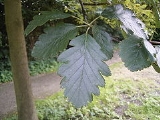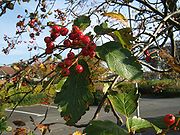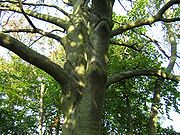
Sorbus intermedia
Encyclopedia
Sorbus intermedia is a species of whitebeam
in southern Sweden
, with scattered occurrences in easternmost Denmark
(Bornholm
), the far southwest of Finland
), the Baltic States
, and northern Poland
.
 It is a medium-sized deciduous
It is a medium-sized deciduous
tree
growing to 10–20 m tall with a stout trunk up to 60 cm diameter and grey bark
; the crown is dome-shaped, with stout horizontal branches. The leaves
are green above, and densely hairy with pale grey-white hairs beneath, 7–12 cm long and 5–7 cm broad, with four to seven oval lobes on each side of the leaf, broadest near the middle, rounded at the apex, and finely serrated margins. The autumn colour is dull yellowish to grey-brown. The flower
s are 15–20 mm diameter, with five white petals and 20 yellowish-white stamens; they are produced in corymbs 8–12 cm diameter in late spring. The fruit
is an oval pome
15 mm long and 10 mm diameter, orange-red to red, maturing in mid autumn. The fruit is dryish, and eaten by thrushes
and waxwings
, which disperse the seed
s.
Sorbus intermedia is a triple hybrid between S. aucuparia
, S. torminalis, and either S. aria
or one of its close relatives. It is closely related to Sorbus hybrida
(Finnish Whitebeam), another species of hybrid origin, which differs in having the leaves more deeply lobed, with the basal two pairs cut right to the midrib as separate leaflets. Both are tetraploid apomictic
species which breed true without pollination.
 It is widely grown as an ornamental tree in northern Europe, valued for its tolerance of urban street conditions; it is very commonly used in avenue
It is widely grown as an ornamental tree in northern Europe, valued for its tolerance of urban street conditions; it is very commonly used in avenue
s and urban parks. It is frequently naturalised
in the British Isles. In recent years, much new planting of "Swedish Whitebeam" has actually been of the related Sorbus mougeotii
(Vosges Whitebeam), another apomictic species from further south in Europe that has more erect branching, less deeply lobed leaves with whiter undersides to the leaves, and darker red fruit.
Whitebeam
The whitebeams are members of the Rosaceae family, comprising subgenus Aria of genus Sorbus, and hybrids involving species of this subgenus and members of subgenera Sorbus, Torminaria and Chamaemespilus. They are deciduous trees with simple or lobed leaves, arranged alternately...
in southern Sweden
Sweden
Sweden , officially the Kingdom of Sweden , is a Nordic country on the Scandinavian Peninsula in Northern Europe. Sweden borders with Norway and Finland and is connected to Denmark by a bridge-tunnel across the Öresund....
, with scattered occurrences in easternmost Denmark
Denmark
Denmark is a Scandinavian country in Northern Europe. The countries of Denmark and Greenland, as well as the Faroe Islands, constitute the Kingdom of Denmark . It is the southernmost of the Nordic countries, southwest of Sweden and south of Norway, and bordered to the south by Germany. Denmark...
(Bornholm
Bornholm
Bornholm is a Danish island in the Baltic Sea located to the east of the rest of Denmark, the south of Sweden, and the north of Poland. The main industries on the island include fishing, arts and crafts like glass making and pottery using locally worked clay, and dairy farming. Tourism is...
), the far southwest of Finland
Finland
Finland , officially the Republic of Finland, is a Nordic country situated in the Fennoscandian region of Northern Europe. It is bordered by Sweden in the west, Norway in the north and Russia in the east, while Estonia lies to its south across the Gulf of Finland.Around 5.4 million people reside...
), the Baltic States
Baltic states
The term Baltic states refers to the Baltic territories which gained independence from the Russian Empire in the wake of World War I: primarily the contiguous trio of Estonia, Latvia, Lithuania ; Finland also fell within the scope of the term after initially gaining independence in the 1920s.The...
, and northern Poland
Poland
Poland , officially the Republic of Poland , is a country in Central Europe bordered by Germany to the west; the Czech Republic and Slovakia to the south; Ukraine, Belarus and Lithuania to the east; and the Baltic Sea and Kaliningrad Oblast, a Russian exclave, to the north...
.

Deciduous
Deciduous means "falling off at maturity" or "tending to fall off", and is typically used in reference to trees or shrubs that lose their leaves seasonally, and to the shedding of other plant structures such as petals after flowering or fruit when ripe...
tree
Tree
A tree is a perennial woody plant. It is most often defined as a woody plant that has many secondary branches supported clear of the ground on a single main stem or trunk with clear apical dominance. A minimum height specification at maturity is cited by some authors, varying from 3 m to...
growing to 10–20 m tall with a stout trunk up to 60 cm diameter and grey bark
Bark
Bark is the outermost layers of stems and roots of woody plants. Plants with bark include trees, woody vines and shrubs. Bark refers to all the tissues outside of the vascular cambium and is a nontechnical term. It overlays the wood and consists of the inner bark and the outer bark. The inner...
; the crown is dome-shaped, with stout horizontal branches. The leaves
Leaf
A leaf is an organ of a vascular plant, as defined in botanical terms, and in particular in plant morphology. Foliage is a mass noun that refers to leaves as a feature of plants....
are green above, and densely hairy with pale grey-white hairs beneath, 7–12 cm long and 5–7 cm broad, with four to seven oval lobes on each side of the leaf, broadest near the middle, rounded at the apex, and finely serrated margins. The autumn colour is dull yellowish to grey-brown. The flower
Flower
A flower, sometimes known as a bloom or blossom, is the reproductive structure found in flowering plants . The biological function of a flower is to effect reproduction, usually by providing a mechanism for the union of sperm with eggs...
s are 15–20 mm diameter, with five white petals and 20 yellowish-white stamens; they are produced in corymbs 8–12 cm diameter in late spring. The fruit
Fruit
In broad terms, a fruit is a structure of a plant that contains its seeds.The term has different meanings dependent on context. In non-technical usage, such as food preparation, fruit normally means the fleshy seed-associated structures of certain plants that are sweet and edible in the raw state,...
is an oval pome
Pome
In botany, a pome is a type of fruit produced by flowering plants in the subfamily Maloideae of the family Rosaceae.A pome is an accessory fruit composed of one or more carpels surrounded by accessory tissue...
15 mm long and 10 mm diameter, orange-red to red, maturing in mid autumn. The fruit is dryish, and eaten by thrushes
Thrush (bird)
The thrushes, family Turdidae, are a group of passerine birds that occur worldwide.-Characteristics:Thrushes are plump, soft-plumaged, small to medium-sized birds, inhabiting wooded areas, and often feed on the ground or eat small fruit. The smallest thrush may be the Forest Rock-thrush, at and...
and waxwings
Bohemian Waxwing
The Bohemian Waxwing is a member of the waxwing family of passerines. A sleek bird, 18–21 cm long with a pointed crest, it travels in large, nomadic groups with a strong, direct flight. It breeds in coniferous forests throughout the most northern parts of Europe, Asia and western North America...
, which disperse the seed
Seed
A seed is a small embryonic plant enclosed in a covering called the seed coat, usually with some stored food. It is the product of the ripened ovule of gymnosperm and angiosperm plants which occurs after fertilization and some growth within the mother plant...
s.
Sorbus intermedia is a triple hybrid between S. aucuparia
Sorbus aucuparia
Sorbus aucuparia , is a species of the genus Sorbus, native to most of Europe except for the far south, and northern Asia...
, S. torminalis, and either S. aria
Sorbus aria
Sorbus aria , the Whitebeam or Common Whitebeam is a deciduous tree, compact and domed, with few upswept branches; it generally favours dry limestone and chalk soils. The hermaphrodite cream-white flowers appear in May, are insect pollinated, and go on to produce scarlet berries, which are often...
or one of its close relatives. It is closely related to Sorbus hybrida
Sorbus hybrida
Sorbus hybrida is a species of whitebeam native to Scandinavia in Norway, eastern Sweden, and southwestern Finland, and locally in the Baltic States in Latvia....
(Finnish Whitebeam), another species of hybrid origin, which differs in having the leaves more deeply lobed, with the basal two pairs cut right to the midrib as separate leaflets. Both are tetraploid apomictic
Apomixis
In botany, apomixis was defined by Winkler as replacement of the normal sexual reproduction by asexual reproduction, without fertilization. This definition notably does not mention meiosis...
species which breed true without pollination.
Cultivation and uses

Avenue (landscape)
__notoc__In landscaping, an avenue or allée is traditionally a straight route with a line of trees or large shrubs running along each, which is used, as its French source venir indicates, to emphasize the "coming to," or arrival at a landscape or architectural feature...
s and urban parks. It is frequently naturalised
Naturalisation (biology)
In biology, naturalisation is any process by which a non-native organism spreads into the wild and its reproduction is sufficient to maintain its population. Such populations are said to be naturalised....
in the British Isles. In recent years, much new planting of "Swedish Whitebeam" has actually been of the related Sorbus mougeotii
Sorbus mougeotii
Sorbus mougeotii is a species of whitebeam native to the mountains of central and western Europe from the Pyrenees east through the Alps to Austria, and north to the Vosges Mountains....
(Vosges Whitebeam), another apomictic species from further south in Europe that has more erect branching, less deeply lobed leaves with whiter undersides to the leaves, and darker red fruit.

